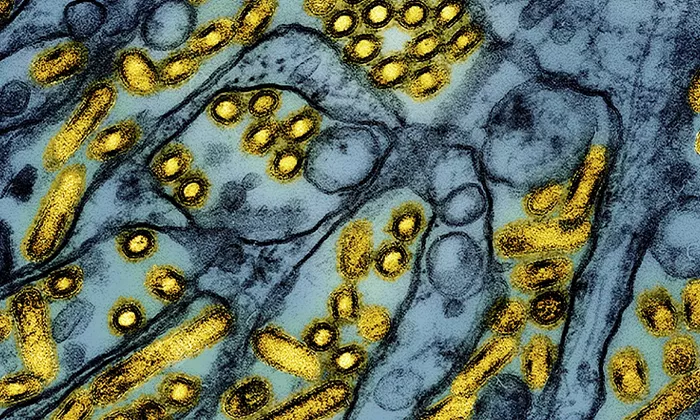A team of scientists has shed new light on how the highly contagious H5 avian influenza virus is evolving and spreading across the globe. Their findings, published in Nature Reviews Microbiology, detail how this virus is infecting a growing number of animal species and showing signs of adapting to humans.
A Dangerous Virus With Global Reach
Since first emerging in 1996 in domestic geese in Guangdong, China, the H5 virus from the Gs/Gd lineage has caused large outbreaks in poultry and wild birds. It has also spilled over into mammals, including tigers, sea lions, mink, and even humans. Now, it has reached every continent—Antarctica included.
Despite years of surveillance and containment efforts, scientists say the virus continues to evolve in unpredictable ways. Its growing ability to infect more species and resist the immune defenses of mammals is raising serious public health concerns.
What Are Influenza A Viruses?
Influenza A viruses have caused four major human pandemics in the past 100 years. Many strains circulate quietly in wild waterbirds. But sometimes, these viruses mutate and become deadly—especially subtypes like H5 and H7.
When avian flu viruses infect poultry, they may change into highly pathogenic forms. These can cause widespread illness and death in animals and can sometimes infect humans.
The Gs/Gd lineage of H5 viruses is one of the most dangerous. This group includes H5N1, which was first identified in humans in Hong Kong in 1997, and other H5Nx variants. Over the years, this virus group has splintered into many new forms, spreading widely across the world.
What Did the Study Examine?
Researchers at the Department of Viroscience at Erasmus MC in the Netherlands conducted a broad review of scientific studies and virus data. They wanted to understand how H5 viruses in the Gs/Gd lineage have changed over time and how they spread among animals and people.
The review traced the virus’s journey over the past 25 years. It started with domestic poultry in China, then jumped to wild birds, and more recently to mammals like mink and sea lions. The virus has even reached dairy cattle in the U.S.
One focus was on how the virus changes through a process called reassortment. This happens when a host (such as a bird or mammal) is infected with two or more flu viruses at the same time. The viruses can exchange genetic material, creating new variants with different properties.
The study also looked at specific changes in the virus’s structure that help it infect mammals. For instance, some mutations in a protein called hemagglutinin make it easier for the virus to attach to cells in mammals. Changes in the virus’s RNA polymerase can also help it reproduce more efficiently in these hosts.
In addition, the scientists studied how different species respond to the virus and how the virus can sometimes escape immune defenses. They also examined how farming practices, human behavior, and environmental factors contribute to the virus’s spread.
Key Findings: A Virus That Won’t Stop Spreading
The researchers found that the Gs/Gd H5 viruses have evolved significantly. Once limited mostly to birds, they now infect many mammals. The virus’s ability to mix with other flu strains has helped it adapt to new hosts and spread more easily.
One of the most concerning developments is the virus’s spread among dairy cows in the United States. On infected farms, the virus is moving between cows—likely through contaminated milking equipment and animal movement.
The virus’s global spread is unmatched. For the first time, it has been found in every continent, including Antarctica.
Its ability to bind to human-like receptors and evade the immune systems of mammals shows that it is becoming better at infecting people. So far, there have been over 1,000 confirmed human cases since 1997, with more than 500 deaths. However, these numbers are likely underestimates because mild or symptom-free cases often go undetected.
Most human infections have occurred after contact with infected poultry. But recent U.S. cases involving dairy farm workers point to new transmission routes.
Though the virus hasn’t yet shown sustained human-to-human transmission, scientists are concerned. As more mild human infections occur, the chance of the virus adapting further increases.
Severe Impact on Wildlife
The H5 virus has taken a heavy toll on wild animals. Sea lions, seals, and many bird species have died in large numbers, especially in the Americas and Europe. There have also been cases of mammal-to-mammal transmission, such as in mink farms and sea lion colonies. This suggests the virus is becoming more capable of spreading among mammals.
Unfortunately, there are few ways to control outbreaks in wildlife. Some options include removing animal carcasses and possibly vaccinating endangered species.
Why This Matters for Human Health
Experts say the virus’s growing presence in mammals and its expanding global range make it a serious threat to
public health. Even though it doesn’t yet spread easily between people, it is getting closer to being able to do so.
If the virus gains the ability to spread efficiently among humans, it could lead to a new pandemic.


